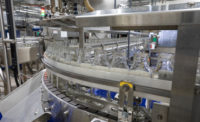Keith Reisinger originally conceived the idea of the Pixie regional Australian ice cream brand — headquartered in Toowoomba, Queensland, Australia — 60 years ago. His ice cream creations, made from natural fresh ingredients from the region, were so well received that the family business is now in its third generation.
The company used the Queensland government´s Made in Queensland grants initiative, which supports small-to-medium-sized manufacturers, as a stepping stone to position itself for the international market. With the help of the government grant of $1,496 million Australian dollars, Pixie invested in innovative automation and technology solutions that significantly increase production volumes. The objective is to expand the sales of Pixie ice cream to North America and the Asia-Pacific region.
With the grant funding it acquired, Pixie switched to automated packaging. Now, a combination of a picker line and a packing line from Crailsheim, Germany-based Schubert packs the ice cream on a stick into a variety of cartons and plastic boxes. Through the joint development of the top loading machine (TLM) system, the two innovative companies quickly established a close relationship.
“We first came into contact [with Schubert] at the 2016 PackExpo in Chicago,” said Brendan French, business manager at Pixie. “The visit to the Crailsheim plant ultimately convinced us that with Schubert, we had chosen the right partner to step into the world of automation. Their innovative strength, leading technologies and the modular, flexible concept of the TLM machines suit our ideas perfectly.”
The challenge of available space and packaging design
The switch to automated packaging entailed a number of requirements for the new packaging machine. It was important to be able to package the previously frozen flow-wrapped ice cream online (i.e., sorted and directly from production), as well as offline (i.e., mixed assortments from storage). The entire system had to be extremely compact so it wouldn’t exceed the limited hall space.
Additionally, Pixie required a large variety of formats: The milk and fruit ice-cream varieties are packed both into cartons of various sizes and into plastic work in progress (WIP) containers.
In an early development phase, Schubert identified another challenge: The cartons used are very high and allow very little leeway for the products. Moreover, the ice cream is not always in an identical position in the flowpacks.
When a robot grips the product, the empty ends of the flowpacks protrude by varying distances. When placing them into the carton over the high edge, these “fins” can quickly stick to the carton wall. This delays the process flow and the products are not stacked well enough in the secondary packaging.
Development in close collaboration with Pixie
To prevent this, Schubert’s specialists worked closely with Pixie to optimize the packaging design and ensure a secure packaging process. The carton remains open at the front during packaging since it is not glued all the way round, as would usually be the case. The front carton wall tilts slightly forward, enlarging the opening to insert the products.
Additionally, the individual flowpacks are positioned at an angle when they are inserted. Only once the carton has been filled is it closed with an attached lid and a three-sided closure. The new carton variants were selected to ensure that all formats are sufficiently pressure-resistant for storage and transport.
For customized solutions such as this one, Schubert draws on its decades of experience as a manufacturer of packaging machines. This works best when we it can work closely with the customer — even over such long distances. Pixie is extremely cooperative, and Schubert developed an exceptionally close customer relationship with the family-run company in a very short time.
A combined system with modular Schubert technology
The new TLM system consists of seven modules and combines the picker line and packing line in a compact 13.8-meter system. This is made possible by the use of the counterflow principle and the Schubert Transmodul transport robot.
With the Transmodul, cartons and plastic boxes are moved variably from one station to the next within the system. All secondary packaging is fed into the system via the magazine, including the stackable WIP containers. This eliminated the need for a space-consuming feed with a belt from the outside and the transfer to the system.
When the machine is operating online, the ice cream on the stick is automatically fed from production and the flow-wrapping machine via a product belt into the machine. Offline, the products are fed manually by loading them onto 10 tangential belts. At the end of each pair of belts, there is a pick-and-place robot placed (a total of five robots).
With their individual tools, the robots carefully pick up the flow-wrapped ice creams and place them into the cartons. During the automatic changeover from online to offline, the pick-and-place robots are moved to their respective positions. All infeed belts are equipped with incident light scanners — Schubert’s image recognition systems — that identify the position of the products on the belt. The format changeover of the system also is automated to the greatest possible extent by flexible tools.
Long-time partner Selpak in Australia
Although Pixie is based in Australia, the distance was not an issue when it came to installing the packaging line. Within seven weeks, the Pixie system was shipped to Queensland. The modular system concept required only a few days for assembly.
With Selpak, Schubert has a long-standing local partner that knows its technologies very well. The employees there support the company every time a Schubert system is commissioned in Australia. Also, all of Schubert’s Australian customers rely on Selpak’s experts to service their existing equipment.
Options for the future
With the new packaging line, Pixie can now significantly increase its production capacity and not only better serve the Australian market, but also position itself internationally. The close relationship with Schubert will also make it possible to smoothly implement further automation in production together in the future.











